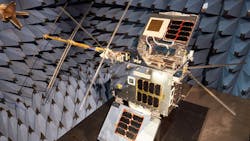According to Research and Markets, the global space-based laser communication market will hold a projected value of $10.72 billion by 2033, achieving a compound annual growth rate (CAGR) of 13.43% over 10 years. The analysis attributes this substantive growth primarily to two factors. First, technological advances like artificial intelligence (AI) and inter-satellite links (ISLs) enhance communication performance in both terrestrial and space environments. Second, industry giants, such as SpaceX and Amazon, and optical communication experts, like Cailabs and TNO, are introducing new research and solutions to address challenges and create new opportunities.
The difference with light
This news comes as no surprise, considering the potential of laser satellite communication. Unlike traditional radio frequency waves that power today’s Wi-Fi, Bluetooth, and 5G technologies, laser satellite communication offers a quicker and more secure method of data transfer. With speeds 100 to 1000 times faster than radio frequencies, this technology can deliver multiple gigabytes of data per second. By employing narrow optical laser beams, laser satellite communications are smaller, lighter, and more energy-efficient while being more difficult to intercept and, thus, more secure.
Leaders making waves
However, employing this form of communication has eluded researchers—until recently.
For instance, in January, TNO reported that they successfully connected a satellite to a ground station on Earth via self-developed laser communication technology—the first time this has been achieved with a Dutch laser satellite instrument. Its success stemmed from alignment with the SmallCAT (Small Communication Active Terminal) system, launched in April 2023 by SpaceX. According to TNO, the system, flying in low Earth orbit, managed to establish a connection with optical ground stations in The Hague (TNO) and Tenerife (ESA ESOC’s IZN-1) and successfully transmitted and received laser beams with extreme precision, achieving a maximum data rate of one gigabit per second.
Also in January, Optica Corporate Member Cailabs announced they established a ground-to-artificial satellite link over a distance of 2.5 km. The company developed an Optical Ground Station (OGS), backed by France’s Ministry of Defense, and leveraged an off-the-shelf Optical Communication Terminal (OCT) on an artificial satellite. To establish the link, the team remotely operated the OGS and synchronized it with the OCT using a beacon signal. The alignment between the two allowed the OCT to send communication signals to the OGS, demonstrating the OGS’s operational capability in optical space communication.
Continuing to tackle challenges
These first iterations merely scratch the surface of what’s to come. For example, TNO plans to explore advancing the technology under various atmospheric conditions to enable applications as varied as providing high-speed internet in remote areas, developing quantum-safe encryption methods, and equipping self-driving cars with more secure connections.
All companies researching laser satellite communication will need to continue working to address the tight alignment tolerance necessary and end-point alignment maintenance challenges that will make this technology a viable commercial solution.
A bright future
Challenges aside, as the technology begins to scale, new milestones will be demonstrated, and the R&D will move from prototype to product reality. While technology takes time, increasing bandwidth requirements offers a highly motivating—and potentially lucrative—drive toward a marketable solution.
In the meantime, laser communication scientists and engineers will continue to unpack new research, consider obstacles from a solution perspective, and advance this work. For example, Optica is holding a complimentary Online Industry Meeting on NewSpace on February 27, from 10:30 to 11:30 GMT-5, to facilitate conversations and bring together prominent researchers to share what’s next for development. Join us to help drive the conversation.
